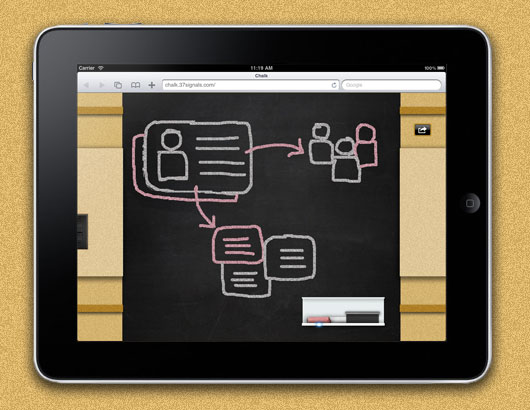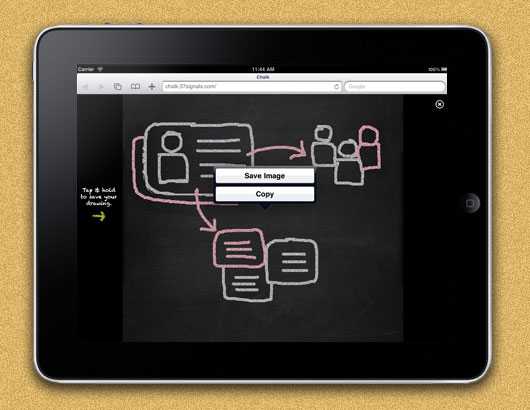No is easier to do. Yes is easier to say.
Backpack journal meets Adium
At 37signals, Backpack’s Journal feature answers the “Hey, what are you working on right now and what have you done lately?” question.
We wanted to make it easier to get journal entries into Backpack so we added a tiny wrapper around the existing journal API to make it work with a couple of StatusNet desktop clients (Adium is probably the most famous one). Now you can follow everyone else’s journal updates and make your own updates directly from a desktop client.
Here’s how you can use Backpack journal entries with the latest Adium.
Continued…Introducing Chalk: A fun little browser-based app for iPad inspired by our new office
My favorite thing about the 37signals office are the 4 team rooms. Team rooms are where people can work together uninterrupted without disturbing anyone else. These team rooms are equipped with big chalkboards. You can sketch something quickly, erase it, and draw in more detail. Sketching on a chalkboard isn’t just a solo effort either. It’s collaborative. Anyone can add to your sketch to enhance your idea.

We love the interior design details of chalkboard and cork in our team rooms. Could we simulate the team room experience on the iPad? Luckily Sam Stephenson and I had some spare time between projects — an hour here, a few hours there — 3 days later we came up with Chalk. We’re really pleased with the results, and we want to share it with you.
One of the coolest things about Chalk is it’s a website. There’s no app store approval process we had to endure. We used technologies we’re already familiar with. To use Chalk just go to chalk.37signals.com on your iPad.
Instead of making a full-fledged sharing feature for Chalk, we decided to just use the iPad’s Photos app. You can save or copy your drawing by using the “tap and hold” gesture. This puts the drawing into the Photos app where you can attach it to an email.
The Chalk web-app feels even more like a native app when you add it to your Home screen. Sam got Chalk to work even if you don’t have internet access. As long as it has been bookmarked already or on the Home screen it’ll work anywhere. Here’s a quick 1-minute demo movie if you want to see it in action.
It’s cool to work for a company that doesn’t frown on experiments like this. I had fun making the team room in Photoshop (yes we do use it on occasion). Sam had fun making it all work. We hope you have fun using it!
We’d love to see what you make with Chalk. Please send us your drawings: [email protected]. We might even publish a few of them here on SvN.
You may be wondering how this relates to Draft, our native iPad app for quick sketches. It doesn’t, really. Draft is a different product for different needs. Chalk was a fun experiment that lets you draw something quick in a browser.
Apple's responsibility as a superpower
Apple has decreed that Flash must die and developers everywhere have shown up with shovels to dig its grave. Now, I’m no dear friend of Flash and I think the energy that is being poured into improving HTML5 on account of its future demise is wonderful for the web. But that doesn’t make me feel any better about Apple’s demonstration of might.
Today we cheer because Flash is every Real Web Developer™’s favorite piñata and what’s more fun than seeing a giant bat it around. It of course doesn’t help that Adobe is a big, stodgy software company with plenty of dysfunctional products. They play the role of a sympathetic victim poorly.
My fear is that Apple will take the expedited death of Flash as an invitation to play king maker with increased abandon. Apple is fighting everyone on all fronts. They’re on the outs with Sony, Google, Motorola, Microsoft, and an endless list of other companies. What technology or technique is next on the hit list? (Think what happened or didn’t to Blue-ray, USB3, Java).
The fact that this is just a general sense of unease about what Apple-the-superpower might do next is exactly why this is so harmful. Once you start flexing your muscles, everyone will be fearing they’re next.
We're hiring a business analyst
We’re looking for someone who loves numbers, loves business, and loves mixing the two. This is your thing.
They might call you an analyst, a business intelligence specialist, a data scientist, an economist, or a statistician. We want to call you part of our team.
You’ll be responsible for reviewing daily sales, upgrades, downgrades, and cancellations. You’ll spot trends, establish and review analytics, monitor conversions, propose, implement, and measure strategies to increase revenues, grow profits, and improve margins. Using data and numbers, you’ll tell us things we didn’t know about our customers.
Our data currently comes from disparate sources including our own databases, raw usage logs, Google Analytics, and occasional qualitative surveys. You’ll be able to look at all of these sources, suggest new sources or metrics we should track, and make sense of it all. We have an abundance of intuition at 37signals. Now we want the data to back it up or prove it wrong.
You’ll be who we go to when we have a question like “How many customers that signed up 6 months ago are still around?” or “What’s the average lifetime value of a Basecamp customer who started on a free account then upgraded to a Premium plan?” or “Which upgrade paths generate the most revenue over a 24 month period?” or “What are the key drivers that encourage people to upgrade their Highrise account?” or “What sort of usage patterns lead to long-term customers?” or “Which customers are likely to cancel their account in the next 7 days?” or “In the long term would it be worth picking up 20% more free customers at the expense of 5% pay customers?”
We’ll use these answers to make decisions that will have significant impact on the business. You’ll love this stuff like we love design, programming, customer service, and product development.
You’ve done this job before and you’ve made a difference. Your insight, your reporting, and your findings have had an positive impact on someone’s bottom line. You also have a strong background in statistical analysis. We usually don’t care about schooling, but in this role it’ll be a distinct plus to see a relevant degree on the resumé.
How to apply
Email a cover letter and work experience to [email protected]. Please put “[BI]” in the the subject so we can filter these applications.
In addition, please include answers to the following three questions:
- Explain the process of determining the value of a visitor to the basecamphq.com home page.
- How would you figure out which industry to target for a Highrise marketing campaign?
- How would you segment our customer base and what can we do with that information?
We look forward to hearing from you.
Bootstrapped, Profitable, & Proud: Admoda
This is part of our “Bootstrapped, Profitable, & Proud” series which profiles companies that have $1MM+ in revenues, didn’t take VC, and are profitable. Terry Jackson of Admoda responds in the comments section to reader questions.
One sign that Admoda, an ad network for mobile phones, is doing things a little bit differently: this press release announcing the company’s rejection of ”$25M of 3rd Round investment.”
Along with the angel investment of $250,000 that Admoda (and sister service Adultmoda) declined initially, the $3M in declined first round funding, and the $10M in declined second round funding, this latest round brings the total investment declined by Admoda to $38.25M…
Terry Jackson, CEO and founder of Admoda, had this to say, “Well, we did consider the traditional N step business plan of startups in the tech sector. But, in the end, we opted for a less-conventional, two-step plan; First, build a profitable business and grow it by re-investing the profits. Second … Sorry, did I say ‘two steps’? There’s just the one, actually.”
A fun little April Fool’s joke — but one inspired by frustration. “Many companies seem far more excited about sending out a press release regarding a round of funding then they would if they clinched a great sale or shipped a superb product,” explains Jackson when asked why the company posted the fake release. “It’s as if raising finance is the end goal for some businesses — like a prize or some kind of status symbol. It’s always press releases about VC funding too — I’ve noticed bank loans are not that cool. Investment is great if it is for the right reasons. But it should not be considered as a goal for a business in itself.”
How Admoda started
Back in 2002, Jackson founded MobVision, a group of businesses selling mobile content and mobile affiliation services. By 2005, he realized clients were struggling for ways to get traffic and thus the idea for Admoda sprouted. He felt that building an ad network for companies to buy and sell mobile traffic seemed a natural service to launch.
In 2006, Jackson (pictured at left) and co-founder David Salgado launched Admoda. It’s a global network run out of London, UK. There’s also a partner service called Adultmoda for mobile ad campaigns aimed at adults.
The founders started out with a set of goals: Bootstrap from the start, avoid the need for investment, provide a great service, build a great place to work, make a lot of money, and have fun. Jackson encourages other startups to also figure out their goals in the beginning. “Every founder should ask themselves: ‘What were the reasons I had for starting my business in the first place? What was I looking for from the business? What excited me? What drove me?’” he explains. “If those things are being achieved, or on their way to being achieved, then the business is successful.”
The founders funded themselves through their own cash, though they didn’t need much capital outlay at first. They launched Admoda as the most basic ad network companies could use to buy and sell traffic. Soon they made money and invested it back in.
The company has been profitable since shortly after launch and the number of ad requests per month has doubled in the last year, according to Jackson. The combined networks currently see over 7.5 billion ad requests per month. While Admoda is slightly larger, Adultmoda is the largest adult mobile ad network in the world.
Productivity as a measure of success
Profit is key, but Jackson feels productivity is also a good way to measure the success of a business. “We far outstrip the productivity of any of our competitors when you compare the volume of business our small team delivers compared to our larger VC funded competitors with their massive pools of staff and global offices,” he says.
Jackson feels using a company head count as something to brag about is ridiculous. (Admoda has a core team of only nine people.) “If you have the productivity to match the head count, great. But raising $40m and recruiting 85 employees does not constitute a good business — or a successful one.”
Exit strategy, or lack thereof
 Admoda isn’t interested in the acquisition game either. He says, “Virtually all mobile phone ad networks at the moment are raising investment, spending money, making a loss, and desperately trying to be acquired by someone with very deep pockets,” he says. “This is not a scenario that comes along and attacks from behind. Companies and the founders create their own destiny. Once you set off on the route of needing to make money you end up on a very different road than companies who don’t necessarily need to make money quickly because they have investment.”
Admoda isn’t interested in the acquisition game either. He says, “Virtually all mobile phone ad networks at the moment are raising investment, spending money, making a loss, and desperately trying to be acquired by someone with very deep pockets,” he says. “This is not a scenario that comes along and attacks from behind. Companies and the founders create their own destiny. Once you set off on the route of needing to make money you end up on a very different road than companies who don’t necessarily need to make money quickly because they have investment.”
Being funded by profit results in different choices. “We have to carefully decide where to channel our available resources,” he explains. “It also means we focus on making money rather than spending it, which requires a very different approach to business compared to many of our competitors. You can sense the desperation from some VC funded mobile advertising companies who are not yet acquired.”
We focus on making money rather than spending it, which requires a very different approach to business compared to many of our competitors.Continued…
Nordstrom's Employee Handbook — short and sweet
For years, Nordstrom’s Employee Handbook was a single 5×8” gray card containing these 75 words:
Welcome to Nordstrom
We’re glad to have you with our Company. Our number one goal is to provide outstanding customer service. Set both your personal and professional goals high. We have great confidence in your ability to achieve them.
Nordstrom Rules: Rule #1: Use best judgment in all situations. There will be no additional rules.
Please feel free to ask your department manager, store manager, or division general manager any question at any time.
During this time, Nordstrom had the highest sales per square foot performance in the retail industry – by almost double. [thx Ian]
The fiddly thing about practice, whether at programming, exercising, playing the trumpet, drawing, or anything else, is that you rarely notice improvement between one session and the next. Don’t let it discourage you. Being consistent over the long haul is what is required. Eventually you’ll look back and realize you’ve climbed a mountain, one day at a time.
Would you expect someone to get a good night’s sleep if they were interrupted all night? Then how can you expect someone to get a good day’s work if they are interrupted all day?
How to hire a programmer when you're not a programmer
How do you hire a programmer if you’re not one yourself? Some things to look for…
1. How opinionated are they?
Ask them about a juicy programming topic (e.g. Ruby or Python?). The tone and reasoning of the answer will reveal a lot. In our recent podcast on programming, Jeff said, “When people have strong opinions about things — when they can talk at length about something — it’s a good indication that they’re passionate about it.”
2. How much do they contribute to open source projects?
Look at their contributions. Though you may not be a coder, you’ll be able to tell if there’s some code there. And the fact that somebody is contributing something is a good start. “The fact that somebody is contributing at all means they’re using the tool,” said Jamis. “It means they’re scratching an itch, like they ran into something that they thought should be improved, or ran into a bug and they fixed it themselves. That level of participation is a good discriminator.”
3. How much do they enjoy programming?
They don’t have to spend every second of their free time hacking, but you do want to see some level of passion. Jamis said, “It’s not so much that coding in your free time is the important thing so much as it is that you’re showing you’re passionate about it and that you have opinions.”
4. Do they actually ship?
Find out how they manage their work. Software often slips — find out how they avoid this. Find out when they shipped something on time and ask why that project was successful. Or find out lessons learned from a delayed project. “The ability to ship software is critical,” according to Jeremy. “How they manage the very task oriented part of actually needing to get something done and finished by a certain time.”
5. What have they mastered?
Randy Nelson of Pixar argues that mastery in anything is a really good predictor of mastering something else. So look for someone who’s mastered something. Is the candidate a great chef? Or mountain biker? Or something else? That’s a sign they can be a master on your project too. “That sense of I’m going to get to the top of that mountain separates them from all of the other candidates almost instantly,” says Nelson. “There’s very little chance that someone’s going to achieve mastery on the job if they didn’t get there before coming to your workplace.”
6. How well do they communicate?
The less you understand about programming, the more you’re going to rely on this person to translate what’s going on to you. That’s why hiring great writers, regardless of the position, is a good idea. For example, here’s Jeff explaining a Basecamp API update to the rest of the team inside the project site:
I just pushed an update to Basecamp’s People and Companies APIs.
We now allow client and firm employees to see people and companies that they have access to through projects. Prior to this update, firm and client employees could only see people using a specific project ID. There was no way for them to see all people (i.e., colleagues) that they are involved with across projects.
For example, if the API user making the request is on one project with Bob and another with Jill, /people.xml will return Bob and Jill. If the requesting user is an administrator, all people in the account will be returned.
The same is true for companies.
When programmers can both code and speak a language that non-programmers understand, things are a lot less likely to go wrong.
Continued…






